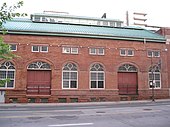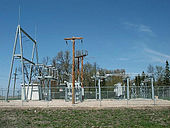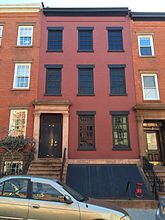Fake building
Buildings that utilize urban camouflage, sometimes known as transformer housings in specific situations and commonly labeled as "fake buildings" and "fake façades" by the public, are structures or purposeful follies designed to disguise electronic transformers and other types of properties that are aesthetically unpleasing in an urban environment.[1][2] These buildings are commonly found in residential towns and cities, where they blend in with the surrounding architecture and hide the presence of hidden equipment.
History
The popularization of urban camouflage dates back to the early 1900s when substations were first introduced in Toronto, Canada.[3] During this period, electronic converters were housed within grandiose abodes rather than being unenclosed or disguised.[3] After the tribulation of World War II, suburbia began to flourish internationally.[4] Due to this eminent boom in society, the electricity demand expanded exponentially, and architects were called to find openings for wanted substations. During this, Harold Alphonso Bodwell, a utility employee appointed to the situation as the lead designer, introduced the idea of disemboweling unused housing for these substations to the directors.[5] One of the earliest known examples of urban camouflage is from 1907 when 58 Joralemon Street in New York was acquired by the Interborough Rapid Transit Company and gutted for the use of ventilating underground transportation.[6]
Usage and placement
Although urban camouflage is typically used to cloak residential substations, there is a multitude of applications for the designation. In Los Angeles, California, many of these structures conceal oil rigs.[7] Other assignments include cell phone towers,[8] bunkers (sometimes nuclear),[9] pump stations,[10] and subway ventilation shafts. Ultimately, these mirages are not inherently installed to prevent vandalism or burglary but rather for the ambiance of its area. Urban camouflage not only maintains property value due to its ambiguous appearance, but it also upkeeps the location's layout. These façades can be discovered internationally from the United States' New York City, New York[11] and Los Angeles, California[12] to Paris, France[13] and London, United Kingdom.[14]
Known locations
This section needs expansion. You can help by adding to it. (December 2022) |
The following is a list of known locations that utilize urban camouflage.
For ventilation
- 145 rue La Fayette. 10th arrondissement of Paris.
- Affiliated buildings of Holland Tunnel. New York City, New York, United States.
- 58 Joralemon Street for rapid transit. Brooklyn Heights, Brooklyn, New York, United States.
- 23/24 Leinster Gardens for rapid transit. London, England, United Kingdom.
For power conversion
- Strecker Memorial Laboratory. Southpoint Park, Roosevelt Island, New York City, United States.
- 51 W Ontario Street. Chicago, Illinois, United States.
- 640 Millwood Road. Toronto, Ontario, Canada.
- 29 Nelson Street. Toronto, Ontario, Canada.
Design
Most examples of urban camouflage are similar to the design of their surrounding buildings, but this isn't always the case. Some instances, however, are less convincing due to design flaws caused by the contained equipment or other difficulties. These flaws include blacked-out windows;[15][16][17] the lack of a roof,[18][16][19] doorway, window panes,[18] or some enclosed walls;[18] gated extrusions; warning signs; and some 3D components printed on rather than replicated with actual materials.[13]
References
- ^ Collyer, Robin. "ARTIST PROJECT / TRANSFORMER HOUSES". Cabinet Magazine. Cabinet Magazine. Retrieved 21 December 2022.
- ^ Pyzyk, Katie. "Fake buildings shrouding transit infrastructure are hiding in plain sight". Smart Cities Dive. Industry Dive. Retrieved 20 December 2022.
- ^ a b "Turning on Toronto: A History of Toronto Hydro". Toronto. City of Toronto. 23 November 2017. Retrieved 21 December 2022.
- ^ Nicolaides, Becky; Wiese, Andrew (2017). "Suburbanization in the United States after 1945". Oxford Research Encyclopedias. Oxford University Press. doi:10.1093/acrefore/9780199329175.013.64. ISBN 978-0-19-932917-5. Retrieved 21 December 2022.
- ^ "Power Houses: Toronto Hydro's Camouflaged Substations". Web Urbanist. Webist Media. 5 February 2012. Retrieved 21 December 2022.
- ^ "Fresh Air for Tunnel: Plant Site Purchased". New-York Tribune. 1907-03-23. p. 4. Retrieved 21 December 2022 – via newspapers.com
 .
.
- ^ Kholstedt, Kurt. "Hollywood-Worthy Camouflage: Uncovering the Urban Oil Derricks of Los Angeles". 99% Invisible. 99% Invisible. Retrieved 21 December 2022.
- ^ Carlson, Cajsa (29 April 2021). "Annette LeMay Burke documents America's camouflaged cell phone towers". Deezen. Deezen. Retrieved 21 December 2022.
- ^ "Fake Chalets: Unmasking the Bunkers disguised as Quaint Swiss Villas". Messy Nessy. 13 THINGS LTD. 26 June 2015. Retrieved 21 December 2022.
- ^ Chan, Casey (21 January 2014). "This normal looking house is fake and actually hides a pump station". Gizmodo. G/O Media Inc. Retrieved 21 December 2022.
- ^ Tedesco, Lianna (12 October 2021). "NYC Is Full Of Fake Facades, And This Is What To Know About Finding Them". The Travel. The Travel. Retrieved 21 December 2022.
- ^ Matthew, Zoie. "4 Oil Wells Hidden in Plain Sight in L.A." Los Angeles Magazine. Los Angeles Magazine. Retrieved 21 December 2022.
- ^ a b Moggia, Silvia (17 January 2017). "Did you know about the fake painted buildings in Paris?". Silvia's Trips. Silvia Moggia. Retrieved 21 December 2022.
- ^ "23-24 Leinster Gardens, London's False-Front House". Britain Express. Britain Express. Retrieved 21 December 2022.
- ^ Batemen, Chris (18 February 2015). "The transformer next door". Spacing Toronto. Spacing. Retrieved 21 December 2022.
- ^ a b Nguyen, Clinton. "8 fake buildings that are actually secret portals". Business Insider. Insider Inc. Retrieved 21 December 2022.
- ^ Carlson, Jen (8 February 2022). "It's a historic townhouse, but 58 Joralemon is also a secret subway exit and shaft house owned by the MTA". Gothamist. New York Public Radio. Retrieved 21 December 2022.
- ^ a b c "No, say it ain't faux! M.T.A. plant hits the fan". amNY. Schneps Media. October 2015. Retrieved 21 December 2022.
- ^ "145 Rue Lafayette". Atlas Obscura. Atlas Obscura. Retrieved 21 December 2022.




